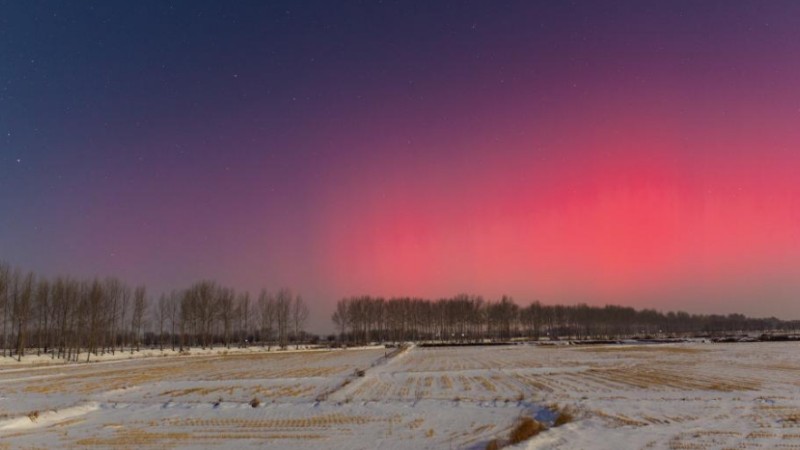County in China's Hunan sees remarkable progress in green development
Located in the Wuling Mountain range's hinterland, Huayuan county in Xiangxi Tujia and Miao Autonomous Prefecture, central China's Hunan Province, has made significant strides in green development over the past decade.
Surrounded by lush mountains, the picturesque village of Shibadong in the county is known for its broad, clean roads and well-maintained houses.

A scenic view of Shibadong village in Huayuan county, Xiangxi Tujia and Miao Autonomous Prefecture, Hunan Province, central China. (Photo courtesy of the Ecology and Environment Bureau of Xiangxi Tujia and Miao Autonomous Prefecture)
"The living environment in our village has changed tremendously," said Long Xianlan, a local beekeeper who has played a key role in increasing villagers' incomes. "In the past, there was pig and cow manure, chicken and dog feces everywhere. It was dirty and smelly. Shoddily constructed sheds were everywhere. The village didn't have a single decent road," he recalled.
"Today, every household keeps the space around their house clean. The forest coverage rate in the village has greatly improved, ensuring abundant nectar sources," Long added.
In recent years, Shibadong village has protected 468 hectares of land under its ecological red-line system. The village has also embraced organic agriculture and green planting methods, improving the rural living environment. It has earned the titles of National Ecological Cultural Village and National Forest Village.
Shibadong village's remarkable transformation symbolizes Huayuan county's commitment to green development. The county has tailored development plans to local conditions, issuing policies that integrate industrial development with improvements in the environment and social governance. This approach has emphasized ecological protection, the cultivation of ecological industries, and a shift in the development model, bringing prosperity to locals and ensuring a healthy environment.
In 2022, Huayuan county recorded good air quality on 95.9 percent of days, a 3 percentage point increase from the previous year. Additionally, all surface water and drinking water sources met quality standards.
Huayuan is home to the largest known manganese ore reserves and the second-largest lead-zinc ore reserves in Hunan. Past unregulated mining and extensive processing have significantly damaged the local environment. Provincial, prefectural, and county governments have made every effort to comprehensively overhaul the mining industry, focusing on ecological protection and restoration and promoting waste recycling.

The top image of this composite photo displays the exterior of Shi Basan's house in Shibadong village, while the bottom image, taken by Chen Sihan on Oct. 20, 2023, shows a current view of the same house. (Photo/Xinhua)
The county has covered more than 13,000 mu (867 hectares) of mines with vegetation, completed ecological and environmental governance in 19 mining villages, and permanently closed 1,195 mine pits in recent years. Dongli village in the county closed all its 100-plus lead-zinc mine pits and covered over 500 mu of mining sites with ornamental trees and flowers, turning it into a picturesque village.
In April 2023, Huayuan's ecological restoration of mines was recognized as one of the 10 classic examples of ecological restoration in Hunan. Additionally, 97.6 percent of county residents reported satisfaction with its comprehensive environmental governance of mines.
The ecological environment of Huayuan continues to improve. The county is now a pilot area for the green transformation and reform of the mining industry in Hunan, a provincial-level demonstration site with clear waters, and a national demonstration area for green mining development.
Huayuan has also accelerated the upgrade of its national 5A-class tourist attraction and the construction of other tourism projects. In 2022, the added value of the county's tertiary industry, primarily its cultural and tourism sectors, represented 52 percent of its GDP. The county recorded 4.13 million tourist visits and tourism revenue of 3.45 billion yuan ($486 million) last year.
In addition to aggressively developing tourism, Huayuan has continuously explored ways to transform its clear waters and lush mountains into valuable assets by promoting modern agriculture, biomedicine, and other green industries. The county aims to become a national model zone for green and low-carbon development.
In May this year, the cargo shipment department of China Railway Guangzhou Group Co., Ltd. launched Huayuan county's first freight train, transporting construction materials made from lead-zinc tailings to Changsha, the capital of Hunan. More than 7 million tonnes of lead-zinc tailings are expected to be reused in the next three years, generating nearly 500 million yuan in annual output value. Additionally, Huayuan has reclaimed 4,326 mu of tailings ponds, generating revenue of 169 million yuan.
Liao Lianghui, deputy Party chief of Xiangxi Tujia and Miao Autonomous Prefecture and Party chief of Huayuan County, stated that the county will adhere to the path of green development.
Photos
Related Stories
- Science forum in SW China's Yunnan highlights green development
- China's Jiangsu boosts green development with heat-storage station
- China sees bright prospects in green development
- Foreign delegation explores green development initiatives in Anji, E China's Zhejiang
- Green development drives enterprise efficiency in NE China province
- Central Chinese city revived after embracing green development
- Leading energy equipment maker powering China's green transition
Copyright © 2023 People's Daily Online. All Rights Reserved.









